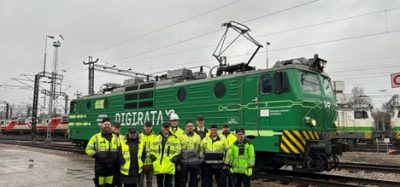ERTMS: from Malaga to Warsaw and beyond
Posted: 15 May 2009 | | No comments yet
Michael Clausecker’s round-up of UIC ERTMS World Conference 2009 which provided a platform for suppliers, railway undertakings, infrastructure managers and political institutions a unique opportunity to express their views on current issues and challenges related to ERTMS.
Michael Clausecker's round-up of UIC ERTMS World Conference 2009 which provided a platform for suppliers, railway undertakings, infrastructure managers and political institutions a unique opportunity to express their views on current issues and challenges related to ERTMS.
Over the past years, the UIC ERTMS World Conference has evolved into a key event for the ERTMS Community; a fact proven once more by its latest edition which took place in Malaga from 31 March to 2 April 2009.
Providing a platform for suppliers, railway undertakings, infrastructure managers and political institutions alike, the conference gave stakeholders a unique opportunity to express their views on current issues and challenges related to ERTMS.
This years’ conference took place not only at the right place, but also at the right time. Many countries have now been successfully implementing ERTMS, whilst recent statistics show that ERTMS is rapidly becoming a global standard.
ERTMS is becoming a global standard
A first major trend discussed in the conference was the ever-increasing interest of countries outside Europe in equipping their networks with ERTMS.
As shown by the UNIFE statistics on ERTMS deployment (available on the website www.ertms.com) that were unveiled during the conference, nearly 50% of total investments are made in countries outside Europe – an impressive result for a system which is nominally defined as ‘European’. Out of the five biggest investors worldwide, three are outside the European Union: China, the largest investor worldwide with more than 5,500km of contracted tracks, Saudi Arabia (3,700km), and Turkey (nearly 2,000km).
ERTMS is, or soon will be, implemented on railway lines in Mexican suburbs, in large parts of the Korean and Taiwanese railway networks, or on lines leading to the Taj Mahal or Mecca. The prospects for the future are equally exciting, as countries such as Australia, Argentina, Morocco and even the US are showing significant interest in investing in ERTMS.
Today, more than 33,000km of railway tracks already operating in the world or contracted to be equipped in the near future and ERTMS emerges as the global signalling standard.
The fact that significant investments have been made by countries outside Europe that have no interest in ‘cross-border interoperability’, leads to a number of conclusions.
Firstly, confidence in the ERTMS standard is extremely high. By definition, countries outside Europe invest in ERTMS simply because the standard is highly reliable, future-proof and offers key advantages in terms of capacity, speed, maintenance cost savings, as compared to other automatic train control systems.
Secondly, the ERTMS business model – i.e. opening the supply market via a signalling standard that can be supplied by an ever growing number of companies – genuinely contributes to this success. Indeed, trackside and onboard equipment may be supplied by any of the ERTMS suppliers as the equipment is fully interoperable – a key advantage for railway companies. The trend to diversification is furthermore manifested in the recent adhesion of AZD Praha to the UNISIG Consortium; the number of ERTMS suppliers is likely to keep rising in the future.
The rise of ERTMS marks a critical change in the old “one system per supplier” philosophy that has prevailed in the rail industry for too many years. It is a key example for the ability of the European rail industry to successfully modernise itself, thereby confirming its position as a global leader.
ERTMS onboard and on track: success stories
A recurrent ERTMS-related question concerns the actual number of track kilometers that are effectively operating ERTMS.
In this regard, the ERTMS conference in Malaga was organised exactly at the right location. Several years ago, Spain made a strong commitment to using ERTMS as the control command system along with major investments in the Spanish railway network. With more than 1,000 track kilometres in operation, and no less than six different suppliers involved in building the ETCS network, Spain is a textbook for using ERTMS. It is now reaping the system’s benefits at high speed.
When the Madrid-Barcelona line went into full commercial service in February 2008, it replaced the busiest flight connection in the world. Today it is acknowledged as one of the most successful examples of modal shift in Europe, paralleled only by the success stories of the Paris-London (Eurostar) and Paris-Brussels (Thalys) lines. Trains enjoy record punctuality rates, whilst travelling between the two cities takes only 2 hours and 38 minutes – compared to 6 hours in the past. In the near future, service in ERTMS Level 2 will reduce the current travel time even further.
More importantly, the return on investment for both infrastructure managers and railway operators is there. Between January and August 2008, the average number of passengers had already increased by 84.5% and the AVE had already taken a share of 40% of all trips between the two cities after just one year of service. ERTMS does not only enable high speeds, but also facilitates a more reliable service. According to ADIF, punctuality rates average around more than 98% on the Spanish ERTMS network. This is a crucial figure in a country where even a 5 minute delay may force operators to refund tickets entirely to customers. The future connection of this line to Southern France will even open new fantastic opportunities for cross-border traffic.
Other lines, such as Cordoba-Malaga, where a test trip was organised during the conference, but also Madrid-Toledo, Zaragoza-Huesca or the so-called “Atocha by-pass” are all running with ERTMS and have recorded equally positive results.
In total, 4,500km of ERTMS-equipped tracks are in operation in Europe to date; in addition to that there are 3,000km outside Europe, in Taiwan and South Korea in particular. Spain is far from being the only European country to implement ERTMS. Italy and Switzerland also have significantly increased the ERTMS share in their network operations, again in a multi-suppliers environment1.
The conclusion to be drawn from these experiences is simple and clear: wherever governments decide to invest, ERTMS has become a success. There have certainly been challenges to overcome in terms of implementation, but wherever ERTMS was installed, customers are enjoying the immense benefits of this advanced technology – performance, reliability and inter-operability. This is why many governments in and outside Europe are drawing plans to expand their network of ERTMS-equipped lines.
An official from the European Commission once said that “with ERTMS, it appears that only those that do not invest complain about it, whereas these countries that actually made the investments are happy with it”. In light of the discussions during the ERTMS Conference in Malaga, this seems to be a fair assessment: Where there is a political will, there is a way!
Shifting debates
Recently, debates around ERTMS have shifted dramatically – something the attendees of the ERTMS conference were also able to witness in Malaga. Whereas in past years discussions circled around the issue of stabilised specifications, they now focus on how to better coordinate ERTMS investments between countries, and on how to tackle non-ERTMS-related issues such as the harmonisation of operational rules. In the past, the very idea of a common signalling standard has been criticised by some. Now, discussions increasingly related centre on how to best and most efficiently implement ERTMS in Europe.
Indeed, major ERTMS implementation plans are being launched in Europe. Thanks to the initiatives of the European Union, such as the European ERTMS Deployment Plan which is currently being adopted, the economic recovery programmes of some Member States that feature a specific budget for ERTMS, more and more European countries are launching significant ERTMS investment programmes. This evolution is highly welcome as the full benefits of ERTMS – i.e. cross boarder interoperability – can obviously only be gained if a significant number of neighbouring countries opt for ERTMS at the same time.
Let us not forget that the principal motive behind developing ERTMS was to endow the rail sector with the means to effectively compete with road transport. ERTMS is the key to cross-border economic competitiveness. The railway sector cannot rely solely on the advantages it brings in terms of environmental protection and climate change. Ultimately, our common success will lie in the way we are able to modernise our railway networks and make them interoperable.
Meeting the deployment challenge
The challenge for the coming years will certainly be the opening of a large number of cross-border connections. Stakeholders know that this will require a strong coordination – non ERTMS-related issues, such as operational rules and cross-acceptance, will also need to be addressed.
In this regard, the recent discussions in various political forums in Brussels and other European capitals clearly show that a vivid dialogue and sharing of expertise are the way forward. The European Institutions should play a vital role in the coming years in launching initiatives on various topics – for instance ERTMS testing, where a ‘European dimension’ would have a strong added value, but also in harmonising operational rules and ensuring a coordinated deployment in Europe.
The responsibility for a successful deployment of ERTMS does not only lie with one stakeholder or another. It is a common duty – for rail suppliers, infrastructure managers, railway undertakings, but also European Institutions and national authorities alike – to make ERTMS a European success. UNIFE is fully prepared to take an active role in the forthcoming debates.
ERTMS proves to be a challenging task for the railway community as a whole. For the rail manufacturers, it introduced the concept of an open supply market with a product that can be installed by any competitor. As to the infrastructure managers and railway companies, it requires them to move from what used to be purely national approaches to a truly ‘European vision’ of railway systems. A worldwide success, ERTMS must now become the main vector for international freight and passenger traffic growth in Europe.
Reference
1. See UNIFE ERTMS Factsheets on Spain and Italy, downloadable on the website: www.ertms.com
Issue
Related topics
Conferences & Events, European Rail Traffic Management System (ERTMS), European Train Control System (ETCS)







